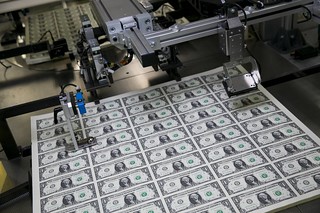
PREV ARTICLE
NEXT ARTICLE
FULL ISSUE
PREV FULL ISSUE
ARTICLE PROFILES FANCY SERIAL NUMBER COLLECTORS
The December 16, 2015 issue of The Wall Street Journal profiled collectors who seek banknotes with special, unusual or
'fancy' serial numbers. Here's an excerpt. -Editor
For a niche of currency collectors, the value of paper currency goes beyond that assigned by the full faith and credit of the U.S. government. These hobbyists appreciate—and often put a premium on—the string of digits in the serial numbers that every bill of every denomination has. Low serial numbers—think 00000001—are a favorite among the group and have some of the loftiest values, sometimes in the thousands if the condition is top-notch. But fans of fancy notes also look for all sorts of other configurations and curiosities that go by a variety of names. There are radars, like 12344321, where the digits read the same both ways as with a palindrome; repeaters such as 20152015, in which the numbers repeat in some fashion; solids like 77777777, which speaks for itself; and ladders like 12345678 where the digits ascend, or descend as the case may be, in order. These notaphilists—as currency collectors are broadly known—have largely remained on the fringe, buying and selling among themselves via fan forums on the Web and scoping their wallets for finds. But the hobby has had something of a star turn over the past year, with attention from the likes of late-night TV host Stephen Colbert stirring up interest from treasure-seekers looking to cash in on their cash. “I had no idea you could get rich collecting money,” Mr. Colbert quipped during a spoof segment on fancy serial numbers in early November. While Mr. Colbert was using the hobby as a punchline, it is simply a fun pastime for most collectors that does, for some, provide a modest sideline to finance their pursuit of notes. “I thought the Colbert bit was funny, even though it’s always a little painful to have people mock your hobby,” says Dave Undis, a longtime fancy-serial enthusiast who has written about the hobby and runs CoolSerialNumbers.com, a website dedicated to fancy bank notes. “People see stuff like that and they start looking in their wallets and start thinking they’re going to get rich,” says the 61-year-old Mr. Undis, a retired insurance executive in Nashville, Tenn. “If you go in as an investment, it’s probably a mistake.” To be sure, some notes can command significant premiums. Low serial numbers often carry the best values for their popularity. One example: A seller on eBay recently was asking $114.99 for a professionally graded $1 bill with the serial number 00000046. But most fancy bills trade only slightly above face value. And many of the most sought-after by collectors really have only sentimental or personal value, like their child’s birthday or an anniversary (04072004, say, for April 7, 2004); ZIP Codes (00090210, where the final five digits in this instance represent the postal designation for Beverly Hills, Calif.); tombstones (19182014, here representing the birth and death years of a long life as they might appear on a gravestone; and others known by such names as Fibonaccis after the mathematical sequence and flippers whose digits look the same right-side up or upside down. This collecting niche hasn’t gone unnoticed by the government. The Bureau of Engraving and Printing sets aside some choice notes—none with serial numbers below 100, however—from its print runs for sale to collectors. One series sold by the bureau included “one $10 note from each of the 12 Federal Reserve Banks” with the lowest serial numbers available.” The set went for $359.40. The bureau also pitches its Lucky Money collection. One example is the bureau’s $1 Fortune Notes, where “each uncirculated note has a serial number beginning with ‘8888’ enclosed in an attractive folder festively adorned with Chinese art and symbolism.“ It aims to capitalize on the 8 being seen as a lucky number in Chinese culture. A single $1 bill in this series goes for $5.95, plus shipping and handling, though customers who buy in bulk can get volume discounts of up to $2 per note for 1,000 or more. As the hobby has picked up attention in mainstream and niche media over the past year, the number of treasure-hunters with dollar signs in their eyes has grown. While Mr. Futrell says he hasn’t seen an increase in sales from this attention, he has seen a boom in requests for the value of bills. “What I have been is bombarded with questions asking about notes’ values,” he says, such as: “Is my note with 66632214 worth anything?” To read the complete article, see:
Wayne Homren, Editor The Numismatic Bibliomania Society is a non-profit organization promoting numismatic literature. See our web site at coinbooks.org. To submit items for publication in The E-Sylum, write to the Editor at this address: whomren@gmail.com To subscribe go to: https://my.binhost.com/lists/listinfo/esylum All Rights Reserved. NBS Home Page Contact the NBS webmaster 
|
